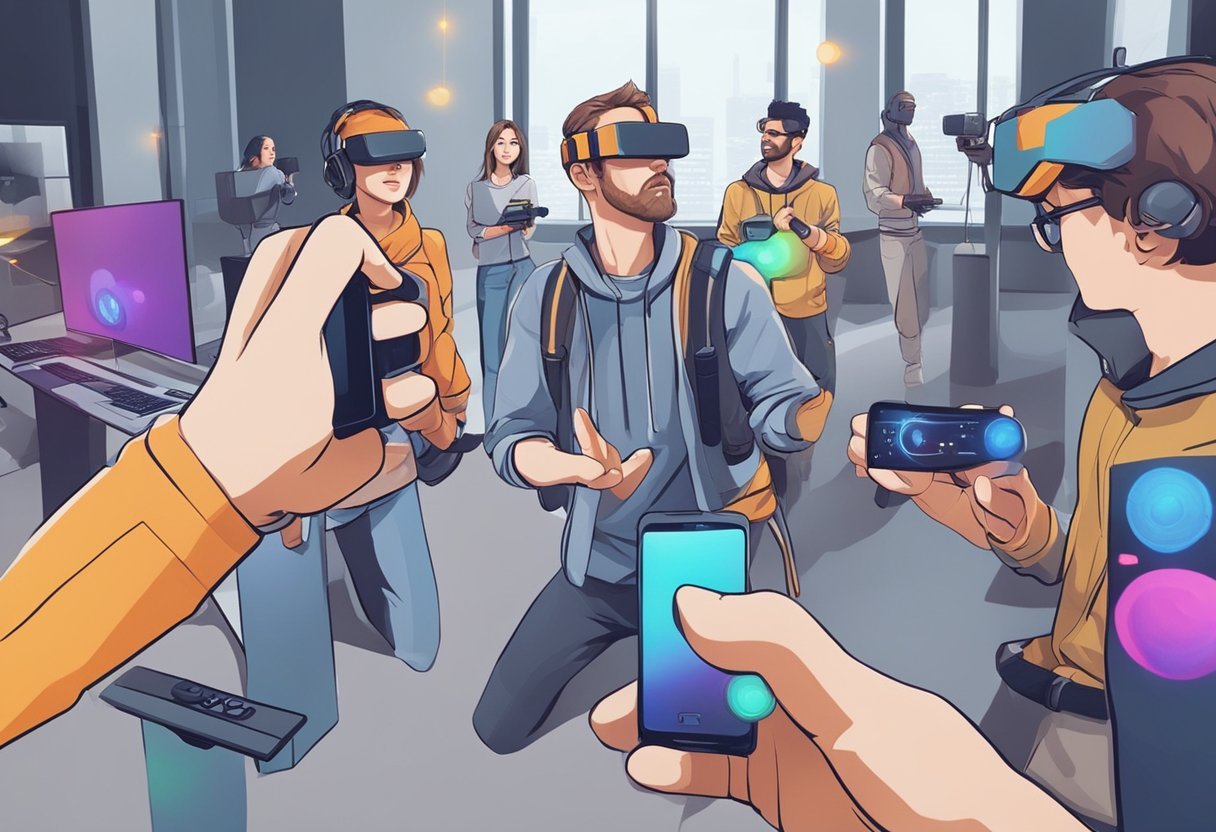Augmented reality (AR) has revolutionized the gaming industry, bringing a new level of immersion and interactivity to gamers. AR gaming is the integration of virtual game elements with the physical environment of the player in real-time. This technology allows players to experience a new level of gaming that blurs the line between the real and virtual worlds. In this blog post, we will discuss the role of Augmented reality in gaming industry and how AR can improve gaming experience.
The evolution of AR gaming has been driven by the core technologies behind it, including computer vision, 3D modeling, and spatial mapping. These technologies have enabled developers to create games that are more interactive and engaging, providing players with an experience that is unlike anything they have ever seen before. AR gaming has had a significant impact on the gaming experience, providing players with a more immersive and realistic experience.
Evolution of Augmented Reality in Gaming
The gaming industry has experienced a significant transformation over the years, with the introduction of Augmented Reality (AR) technology. AR technology has revolutionized the gaming industry, providing gamers with a new level of immersive and engaging experiences.
AR technology was first introduced in the gaming industry, providing gamers with a new level of interactivity and immersion. It allowed gamers to interact with the game world in a more realistic and engaging way. The first AR technology was developed in 1968 at Harvard when computer scientist Ivan Sutherland (named the “father of computer graphics”) developed a head-mounted display system called the Sword of Damocles.
AR gaming has come a long way since the Sword of Damocles, with advancements in technology, increasing smartphone penetration, and a growing demand for more immersive gaming experiences. The AR gaming market is on a trajectory of exponential growth, with the market projected to reach $500 billion by 2030.
AR technology has enabled game developers to create games that blur the line between the real world and the virtual world. Games like Pokemon Go and Ingress have shown that AR gaming has the potential to be a massive success. With the continued advancements in AR technology, we can expect to see more immersive and engaging games in the future.
The evolution of Augmented Reality in gaming has transformed the gaming industry, providing gamers with a new level of interactivity and immersion. With the continued advancements in AR technology, we can expect to see more immersive and engaging games in the future.
The Role of Augmented reality in the gaming industry

1. Enhanced Player Immersion
Augmented reality (AR) in gaming significantly heightens player immersion by blending virtual game elements with the real world. AR gaming leverages the existing environment and overlays digital information on top of it, creating a more engaging and interactive experience for the player. Unlike traditional video games where the interaction is confined to a screen, AR games encourage physical movement and interaction with the game’s elements as they appear in the player’s immediate surroundings.
This integration of real-world elements ensures that each player’s experience is unique, as it is shaped by their environment. For instance, a game that involves finding hidden treasures would turn the player’s real-world location into a digital playground, where they must explore and interact with their surroundings to progress in the game.
2. Social Interaction and Collaboration
AR gaming often includes a social component that encourages interaction and collaboration among players. By superimposing game objectives and elements onto the real world, players are often brought together to achieve common goals or compete against each other.
This communal aspect of AR games can create a sense of camaraderie and competition that is not typically found in traditional gaming. For example, games like Pokémon GO have community events that bring players together in real-world locations to catch rare Pokémon or battle against powerful bosses in raids. These events not only foster social interaction but also create a sense of belonging to a wider community of players who share similar interests.
3. Accessibility and Convenience
One of the key advantages of AR gaming is its accessibility and convenience. Since many AR games are designed for smartphones and tablets, they leverage the ubiquity of these devices to allow a wide audience to engage with AR technology.
Players do not need expensive gaming consoles or high-end computers to enjoy AR games; instead, they can simply download an app on their mobile device and start playing. This ease of access has contributed to the widespread popularity of AR games, making them more inclusive for people who might not consider themselves traditional gamers.
4. Educational Opportunities
AR gaming also presents numerous educational opportunities. By overlaying educational content onto the real world, AR games can make learning more interactive and enjoyable. For instance, an AR game could teach history by allowing players to witness historical events unfold in their local environment, or it could enhance a museum visit by providing additional information about exhibits when viewed through an AR app. These types of games not only entertain but also educate, making them a valuable tool for schools and educational institutions looking to incorporate technology into their teaching methods.
5. Marketing and Brand Engagement
AR gaming offers innovative ways for brands to engage with consumers. By creating branded AR games or incorporating brand elements into existing AR games, companies can create immersive advertising that is interactive and memorable.
For example, a brand could develop an AR game that requires players to visit their stores to complete certain game objectives, thereby driving foot traffic and increasing brand visibility. This form of marketing can lead to higher levels of engagement compared to traditional advertising methods, as it provides a fun and interactive way for consumers to connect with the brand.
6. Physical Health Benefits
AR games can promote physical activity and contribute to the health and well-being of players. Since many AR games require players to move around in the real world, they inadvertently encourage exercise and outdoor activity. Games that involve walking, running, or performing other physical tasks as part of the gameplay can help players lead more active lifestyles. This is particularly beneficial for individuals who may not be motivated by traditional forms of exercise but are willing to engage in physical activity as part of an entertaining gaming experience.
7. Real-World Exploration and Discovery
Finally, AR gaming encourages players to explore and discover the real world around them. By integrating game objectives with real-world locations, players are incentivized to venture out and visit new places. This can lead to the discovery of local landmarks, parks, and other points of interest that players may not have otherwise visited. AR games can include location-based storytelling, which adds a layer of narrative to the player’s exploration, making the experience both educational and entertaining. This aspect of AR gaming not only enriches the gameplay experience but also fosters a deeper connection between players and their physical environment.
Core Technologies Behind AR Gaming

Spatial Tracking
One of the most crucial technologies behind AR gaming is spatial tracking. This technology enables AR games to map the physical environment and overlay digital content onto it. Spatial tracking is achieved through the use of sensors and cameras that capture the real-world environment and translate it into a digital format that can be used by the game engine.
Game Engine Development
Another critical technology behind AR gaming is game engine development. Game engines are responsible for rendering the digital content and integrating it with the real-world environment. AR game engines must be capable of handling complex spatial tracking data and rendering high-quality graphics in real-time.
AR Hardware
AR hardware is another essential technology behind AR gaming. AR games require specialized hardware such as head-mounted displays, cameras, and sensors to provide an immersive experience. The hardware must be capable of capturing and processing real-world data quickly and accurately to enable seamless integration with the digital content.
AR gaming relies on several core technologies, including spatial tracking, game engine development, and AR hardware. These technologies work together to create an immersive gaming experience that blends the real world with digital content. With the continued advancement of these technologies, we can expect AR gaming to become even more prevalent in the future.
Impact on Gaming Experience
Augmented reality has revolutionized the gaming industry, providing a more immersive and engaging experience to players. Here are some ways AR technology has impacted gaming experience:
Player Immersion
AR technology has enabled game developers to create more realistic and interactive games. With AR, players can experience the game in a more immersive way by interacting with digital objects in the real world. The technology allows players to overlay digital objects onto the real world, making it feel like they are part of the game.
Social Interaction
AR technology has also improved social interaction in gaming. With AR, players can interact with each other in real-time and in the same physical space. This has led to the development of social AR games that promote teamwork and collaboration. Players can also compete with each other in real-time, making gaming more exciting and engaging.
Physical Activity
AR technology has also encouraged physical activity in gaming. With AR, players are required to move around and interact with the real world to progress in the game. This has led to the development of AR fitness games that promote physical activity and healthy living. Players can also explore their environment while playing the game, making it a more enjoyable and interactive experience.
AR technology has had a significant impact on the gaming experience. It has provided players with a more immersive, social, and physically engaging experience. As technology continues to advance, we can expect to see more innovative AR games that push the boundaries of what is possible in gaming.
Leading AR Games and Milestones

Augmented Reality (AR) games have been a game-changer in the gaming industry, providing an immersive gaming experience that blends the real and virtual worlds. In this section, we will discuss some of the leading AR games and milestones that have shaped the industry.
Pokémon GO
Pokémon GO, developed by Niantic, was a massive hit when it was released in 2016. It revolutionized the gaming industry and introduced the world to AR gaming. The game allows players to capture, train, and battle virtual creatures called Pokémon in the real world. The game’s success was due to its innovative use of AR technology, making it one of the most popular AR games to date.
Ingress
Ingress, also developed by Niantic, was released in 2012, preceding Pokémon GO. The game is a location-based, multiplayer, augmented reality game that allows players to explore the real world while engaging in a virtual world. The game’s success paved the way for the development of Pokémon GO, and it remains a popular game to this day.
Harry Potter: Wizards Unite
Harry Potter: Wizards Unite, developed by Niantic, was released in 2019. The game allows players to explore the real world while engaging in a virtual world of Harry Potter. Players can cast spells, brew potions, and encounter magical creatures in the real world. The game’s success is due to its innovative use of AR technology and its connection to the popular Harry Potter franchise.
AR games have come a long way since their inception, and they continue to evolve. These games have set the bar high for future AR games, and we can expect to see more innovative games in the future.
Business Models and Monetization
Augmented reality (AR) has revolutionized the gaming industry by providing immersive experiences to players. As a result, the gaming industry has seen a surge in revenue and growth. To capitalize on this trend, game developers need to adopt effective business models and monetization strategies. Here are some of the most popular methods of monetizing AR games.
In-App Purchases
In-app purchases are a major business model for AR game developers. Players can buy virtual items, speed-ups, or additional services within the game. This model provides a steady stream of revenue for developers and encourages players to spend more time playing the game. To maximize profits, developers can offer a variety of virtual items at different price points to cater to players with different budgets.
Advertising
Advertising is another popular monetization model for AR games. Developers can integrate ads into the game to generate revenue. However, it is crucial to strike a balance between ads and gameplay to avoid annoying players. Developers can also offer players the option to watch ads in exchange for virtual rewards. This model benefits both developers and players, as players can earn rewards without spending real money.
Hardware Sales
Hardware sales are another way to monetize AR games. Developers can create their own AR hardware or partner with existing hardware manufacturers to sell AR devices. This model requires a significant investment but can provide a long-term revenue stream for developers. Developers can create games that are specifically designed for their AR hardware, providing a unique selling point for their products.
The success of an AR game depends on the effectiveness of its business model and monetization strategy. Developers need to carefully consider their options and choose the model that best suits their game and target audience. By adopting the right strategy, developers can create profitable and engaging AR games that captivate players and generate revenue.
Challenges and Limitations
When it comes to the use of augmented reality (AR) in the gaming industry, there are several challenges and limitations that developers and players alike must face. These can be divided into three main categories: technical constraints, user accessibility, and privacy concerns.
Technical Constraints
One of the biggest challenges of AR gaming is the hardware requirements. AR games demand high-performance devices, which can be a barrier to entry for some players. The accuracy of tracking in AR games can be limited by the capabilities of the device’s camera, which can impact the overall experience.
User Accessibility
Another challenge of AR gaming is user accessibility. While AR has the potential to create immersive experiences, it can be difficult for some players to use. For example, players with disabilities may find it challenging to interact with AR games, which can limit their ability to enjoy them fully. Some players may be uncomfortable with the physical movements required to play AR games, which can limit their engagement.
Privacy Concerns
Finally, privacy concerns are another challenge of AR gaming. AR games often require access to a player’s camera and location data, which can raise privacy concerns. Players may be uncomfortable with the idea of their personal information being collected and used by game developers, which can limit the adoption of AR games.
While AR gaming has the potential to create immersive experiences, it is not without its challenges and limitations. Developers must work to overcome these obstacles to create games that are accessible and enjoyable for all players.
Future Trends and Predictions
As augmented reality (AR) technology continues to evolve, it is expected to revolutionize the gaming industry. Here are some future trends and predictions that you should keep an eye on.
Mixed Reality Integration
One of the most significant trends in AR gaming is the integration of mixed reality (MR). This technology combines virtual and real-world elements, providing gamers with a more immersive experience. MR headsets, such as the Microsoft HoloLens, are expected to become more affordable, making it more accessible to the masses. In the future, gamers may be able to explore virtual worlds that are overlaid on top of their real-world surroundings, creating a whole new level of gaming experience.
Advancements in Wearable Tech
Wearable technology is another area that is expected to play a significant role in the future of AR gaming. Wearable devices such as smartwatches, AR glasses, and haptic feedback suits could be used to enhance the gaming experience. For example, a smartwatch could be used to control a game, while AR glasses could provide gamers with a more immersive experience. Haptic feedback suits could provide gamers with a more realistic experience, with the ability to feel the virtual world around them.
Location-Based Entertainment
Location-based entertainment (LBE) is another area that is expected to see significant growth in the future. LBE uses AR technology to create immersive gaming experiences in real-world locations. For example, an AR game could be set in a theme park, where gamers could explore a virtual world that is overlaid on top of the real-world surroundings. LBE could provide gamers with a more social gaming experience, as they could play with friends in real-world locations.
As AR technology continues to evolve, we can expect to see more exciting developments in the gaming industry. With the integration of mixed reality, advancements in wearable tech, and the growth of location-based entertainment, the future of AR gaming looks bright.
Frequently Asked Questions
How is augmented reality enhancing the gaming experience for users?
Augmented reality is enhancing the gaming experience for users by providing an immersive and interactive experience. With augmented reality, users can experience a game in a more realistic way, as the game is overlaid onto the real world. Augmented reality games can be played on mobile devices, which makes them accessible to a wider audience. Users can also interact with the game in a more physical way, as they can move around and manipulate objects in the game world using their device’s camera and sensors.
Can you provide examples of successful augmented reality games?
Yes, there are several successful augmented reality games available on the market, such as Pokemon Go, Ingress, and Harry Potter: Wizards Unite. These games have a large player base and have generated significant revenue for their developers. They have also received critical acclaim for their innovative use of augmented reality technology.
What distinguishes augmented reality games from virtual reality games?
Augmented reality games differ from virtual reality games in that they overlay the game world onto the real world, while virtual reality games create a completely immersive game world. Augmented reality games are played on mobile devices and use the device’s camera and sensors to create an interactive game world. Virtual reality games, on the other hand, require a headset and controllers to create a fully immersive experience.
What are some innovative ideas for augmented reality games currently in development?
Some innovative ideas for augmented reality games currently in development include games that use augmented reality to create interactive educational experiences, games that use augmented reality to create interactive art installations, and games that use augmented reality to create immersive storytelling experiences.
How significant is the market for augmented reality gaming?
The market for augmented reality gaming is significant and is expected to grow in the coming years. According to a report by MarketsandMarkets, the augmented reality gaming market is expected to reach $284.93 billion by 2023. This growth is due to the increasing popularity of mobile gaming and the increasing use of augmented reality technology in other industries.
What are the technical requirements for developing an augmented reality game on Android platforms?
The technical requirements for developing an augmented reality game on Android platforms include knowledge of programming languages such as Java or Kotlin, experience with game engines such as Unity or Unreal Engine, and knowledge of augmented reality frameworks such as ARCore or Vuforia. Developers must also have access to a device with a camera and sensors to test their game.




